The Hindenburg disaster wasn’t just a tragic aviation event; it sparked tales of hauntings and eerie encounters at Naval Air Station Lakehurst. Many believe the spirits of the victims linger, with reports of mysterious footsteps, disembodied voices, and unnerving cold spots. Survivors’ accounts and chilling experiences have fueled local folklore and paranormal investigations, creating a haunting atmosphere surrounding the site. There’s much more to uncover about this intersection of history and the supernatural.
Key Takeaways
- The Hindenburg disaster left a haunting legacy at Naval Air Station Lakehurst, with reports of ghostly encounters linked to the victims.
- Eyewitnesses recount eerie experiences in Hangar No. 1, including mysterious footsteps and chilling sensations of being watched.
- Paranormal investigations in the area have documented unexplained sounds and phenomena attributed to the spirits of those who perished.
- Local folklore intertwines the tragic history of the Hindenburg with ghost stories, enhancing its cultural significance and attracting ghost tours.
- The ongoing fascination with the disaster’s hauntings reflects a blend of historical memory and supernatural narratives, captivating visitors.
The Hindenburg Disaster: A Historical Overview
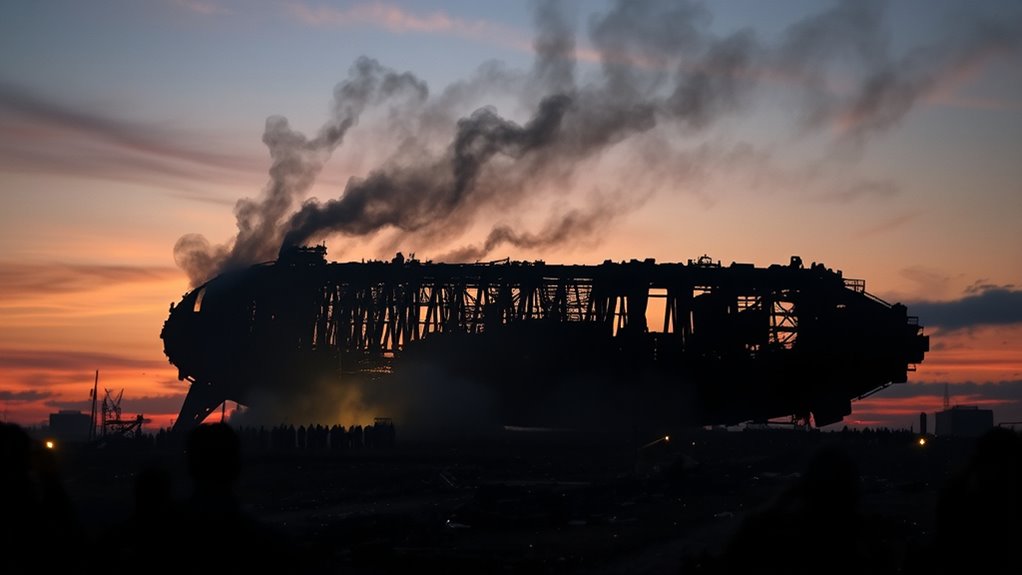
The Hindenburg disaster, which took place on May 6, 1937, at Lakehurst Naval Air Station in New Jersey, marked a turning point in aviation history.
This tragic event involved the German rigid airship LZ 129 Hindenburg, which caught fire while trying to dock. With 97 people on board, including 36 passengers and 61 crew members, the fire erupted just 34 seconds after arrival.
Initial reports suggested ignition might’ve come from static electricity or St. Elmo’s Fire. The disaster resulted in 36 fatalities, severely damaging public confidence in rigid airships.
This catastrophic event signaled the end of the airship era for passenger travel, leaving a lasting impact on aviation history, comparable to the infamous Titanic disaster.
Eyewitness Accounts of the Tragedy
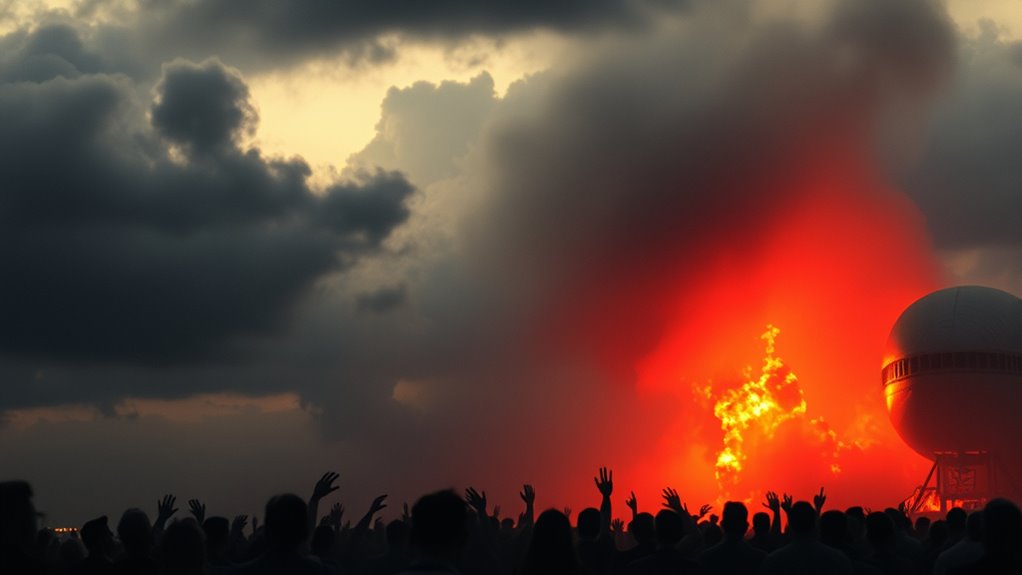
You’ll find that eyewitness accounts of the Hindenburg disaster paint a vivid picture of the chaos and horror that unfolded.
Survivors described the terrifying moment when flames erupted, while others recounted the sickening smell of burning flesh that lingered in the air.
These firsthand experiences provide a chilling glimpse into the tragedy that shocked the world.
Firsthand Survivor Experiences
As the Hindenburg descended towards Lakehurst Naval Station on that fateful evening of May 6, 1937, eyewitnesses felt an unsettling tension in the air.
Survivors like cabin boy Werner Franz shared harrowing experiences of the disaster. They recalled a sudden ignition, a muffled detonation, and then chaos as the airship was engulfed in fire.
- Emotional radio reports captured the despair of the moment.
- Frantic efforts by sailors to rescue trapped survivors were evident.
- Many faced severe burns and trauma, leaving lasting scars.
These firsthand accounts reveal the raw terror and bravery amid the Hindenburg disaster, making the event an unforgettable tragedy in aviation history.
Eyewitness Descriptions of Fire
Flames erupted with terrifying intensity, transforming the Hindenburg into a blazing inferno mere seconds after the initial spark. Eyewitness accounts describe a dim blue flame igniting just moments before the chaos unfolded at 7:25 p.m. on May 6, 1937.
Witnesses reported a muffled detonation onboard, heightening the panic as flames spread rapidly, consuming the airship within 34 seconds. The smell of burning flesh permeated the air, underscoring the tragedy’s grim aftermath.
Some speculated about the ignition source, mentioning static electricity or St. Elmo’s Fire as possible culprits. Amidst the chaos, few had any time for escape, and the horror of that night remains etched in the memories of those who witnessed the devastating fire engulf the Hindenburg.
The Haunting of Naval Air Station Lakehurst
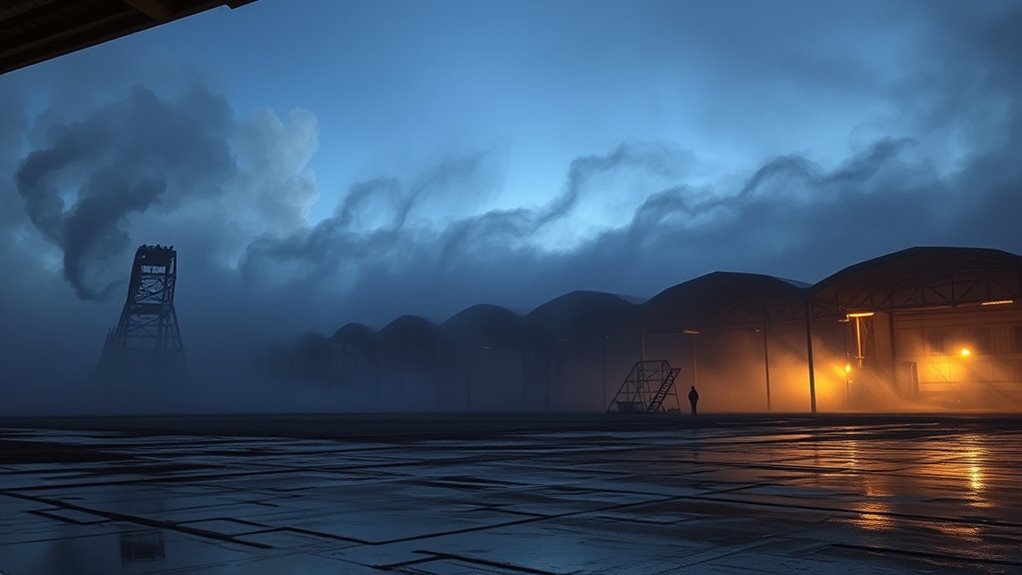
Although the Hindenburg disaster marked a tragic chapter in aviation history, it also paved the way for eerie tales that linger at Naval Air Station Lakehurst. Many believe the spirits of the victims haunt the area, especially in Hangar No. 1, which served as a morgue after the catastrophe.
Witnesses report unsettling feelings and eerie sounds, like footsteps echoing in the rafters.
- Unexplained occurrences include sudden cold spots and loud crashes.
- SEABEES stationed there have fled in fear after chilling encounters.
- The tragic events of the Hindenburg disaster contribute to its legacy as a hotspot for ghostly tales.
The air station’s history keeps the stories alive, inviting those curious about the paranormal.
Apparitions and Eerie Experiences

Many who’ve worked at Naval Air Station Lakehurst have shared chilling accounts of apparitions and eerie experiences that seem to linger in the air.
Those who enter Hangar No. 1 often report unsettling feelings and bad vibes, remnants of the Hindenburg crash. You might hear mysterious footsteps echoing in the rafters, adding to the haunting atmosphere.
Entering Hangar No. 1, one can sense the unsettling echoes of the Hindenburg crash, accompanied by eerie footsteps above.
Witnesses describe ghostly sightings and unexplained shadows darting through the space, suggesting the spirits of victims still roam. Eerie sensations wash over you, making you question if you’re truly alone.
Some personnel have even encountered rattling doors and other strange occurrences, reinforcing the belief that residual energies from that tragic day continue to haunt the clinic and surrounding areas at Lakehurst.
The Legacy of the Hindenburg in Popular Culture

The Hindenburg disaster has left an indelible mark on popular culture, shaping how we view air travel and technology’s perils. Its legacy resonates through various media, cautioning us about human hubris and the limits of technological advancement.
- Iconic newsreel footage and photographs symbolize the fragility of air travel.
- Herbert Morrison’s heartfelt radio broadcast, with the phrase “Oh, the humanity!”, has become a poignant expression of tragedy.
- Artifacts from the Hindenburg, displayed in museums, educate the public about this disaster’s history and impact, often likened to the Titanic.
This cultural impact guarantees that the Hindenburg disaster remains a powerful reminder of the risks associated with innovation.
Ghostly Sightings and Paranormal Investigations
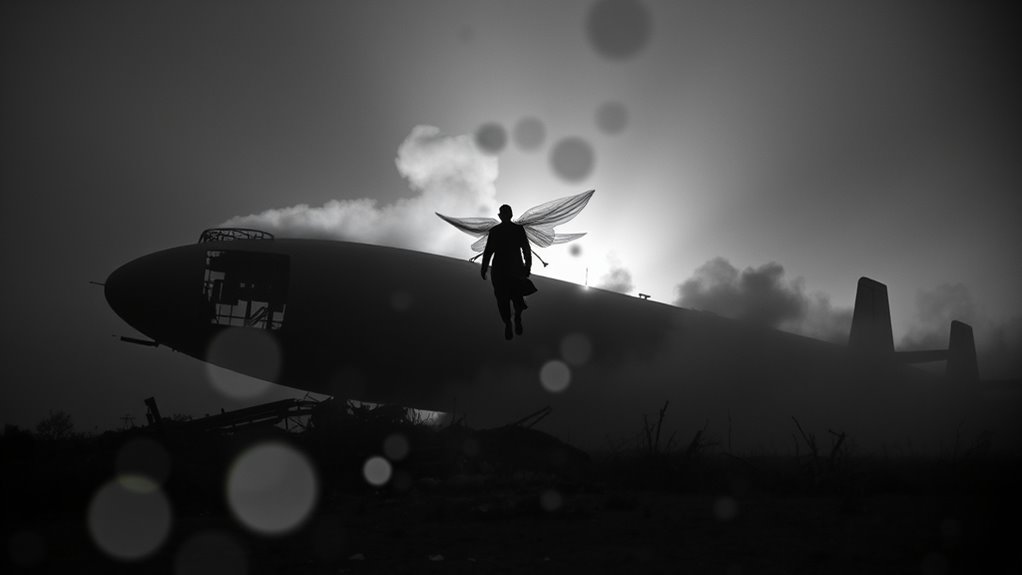
As stories of the Hindenburg disaster continue to echo through popular culture, they’ve sparked a fascination with the ghostly sightings and paranormal phenomena surrounding the site of the tragedy.
At Lakehurst Naval Air Station, eerie experiences abound, particularly in Hangar No. 1, once a morgue for victims. Eyewitnesses report unsettling feelings and mysterious footsteps, while paranormal investigations have documented unexplained sounds attributed to the spirits of victims.
At Hangar No. 1, eerie footsteps and unsettling feelings hint at the restless spirits of the Hindenburg victims.
The clinic built in 1921 is also rumored to be haunted, with rattling doors and flickering lights adding to the intrigue.
Ghost tours frequently explore the hangar area, solidifying its status as a paranormal hotspot, drawing in those enthusiastic to connect with the past and uncover its lingering mysteries.
The Intersection of History and the Supernatural
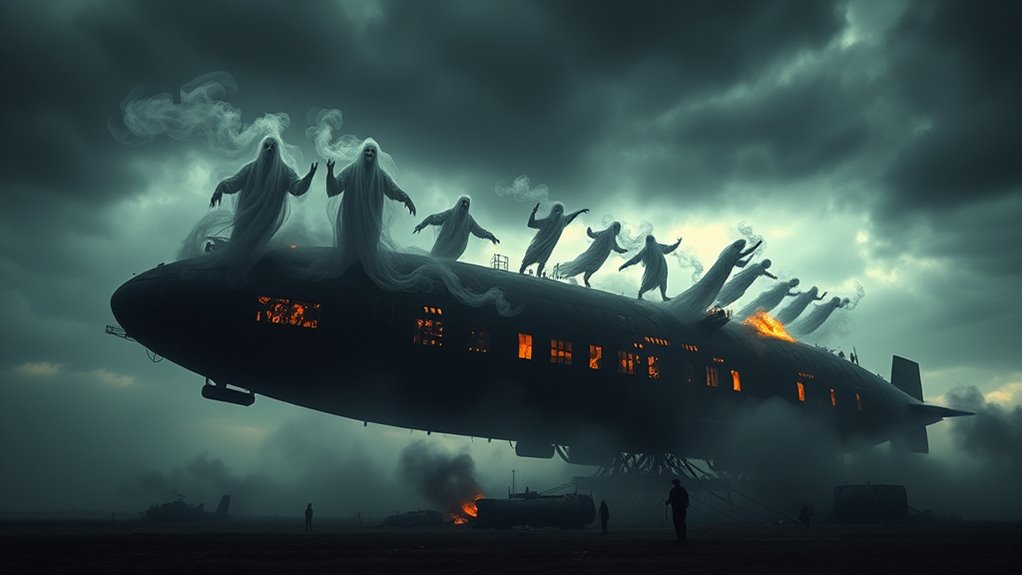
As you explore the haunting legends surrounding the Hindenburg disaster, you’ll find that eyewitness accounts often blur the line between history and the supernatural.
Reports of unexplained footsteps and eerie sensations in Hangar No. 1 suggest a lingering presence tied to the tragedy.
This intersection of aviation history and ghostly tales captivates both historians and thrill-seekers alike.
Haunting Legends Persist Today
While many historical sites carry tales of the past, the Naval Air Station Lakehurst stands out for its chilling connection to the Hindenburg disaster.
This location’s haunted reputation stems from unsettling reports of ghostly sounds and footsteps echoing in Hangar No. 1, once a morgue for the disaster’s victims. The emotional weight of the 36 fatalities contributes to its allure in supernatural folklore.
- Strange occurrences, like rattling doors and disembodied voices, keep the legend alive.
- Eyewitnesses describe feeling an eerie presence while working in the clinic and surrounding areas.
- The intersection of historical significance and tragedy fuels curiosity about the spirits that linger there.
You can’t help but feel the connection between history and the supernatural at this haunting site.
Eyewitness Accounts of Spirits
Eyewitness accounts from those who’ve worked at Naval Air Station Lakehurst reveal a haunting presence that’s hard to ignore. Many believe the spirits of the Hindenburg victims linger in Hangar No. 1, where they were taken after the tragedy.
Personnel have reported unsettling experiences, such as unexplained footsteps and disembodied voices echoing in the hangar. This haunted location has a reputation bolstered by tales of rattling doors and sudden cold spots.
Witnesses often describe an overwhelming emotional presence, feeling deep sorrow and dread while near the site. These chilling accounts contribute to the rich tapestry of ghost stories surrounding the area, blurring the lines between history and the supernatural, as the past continues to resonate.
Historical Context of Hauntings
The haunting tales surrounding the Hindenburg disaster reveal how deeply intertwined history and the supernatural can be. At Naval Air Station Lakehurst, the tragic history of this event has birthed ghostly encounters, with eyewitness accounts detailing unsettling experiences.
Many report unexplained noises, like mysterious footsteps and flickering lights, believed to be tied to the spirits of Hindenburg victims lingering in the area.
- The Hindenburg disaster marks a pivotal moment in aviation history.
- Local folklore enriches the narrative, weaving together tragic history and paranormal tales.
- The ongoing fascination with these ghostly encounters captivates visitors, blending historical events with the supernatural.
- Similar to historical farmhouses, the site serves as a reminder of the past, drawing connections between history and hauntings.
In this way, the Hindenburg disaster continues to resonate, echoing both sorrow and intrigue.
Frequently Asked Questions
What Was the Mystery of the Hindenburg Disaster?
The mystery of the Hindenburg disaster revolves around its sudden and catastrophic fire during landing.
You might wonder what really caused it; while initial theories suggested sabotage, investigations leaned toward an electrostatic discharge igniting a hydrogen leak.
Eyewitness accounts mentioned a strange blue flame before the blaze erupted, fueling speculation.
The combination of technology, human error, and possible natural phenomena creates an enigmatic narrative that continues to fascinate historians and aviation enthusiasts alike.
Did the Dog on the Hindenburg Survive?
Oh sure, because when disaster strikes, it’s always the dog that steals the show.
But yes, Daisy, the German Shepherd aboard the Hindenburg, did survive. She got flung from the airship during the explosion and was later found by the ground crew.
Daisy’s miraculous escape amidst such chaos reminds us that even in tragedy, some stories take a twist that leaves you scratching your head and wondering about the priorities of life.
What Is the Story Behind Hindenburg?
The Hindenburg was a massive airship that represented cutting-edge technology in the 1930s.
You’d see it as a marvel, measuring 804 feet long and filled with hydrogen.
On May 6, 1937, it tragically caught fire while docking, leading to the deaths of 36 people.
This disaster marked the end of the airship era, drastically changing public perception of air travel and highlighting the dangers associated with hydrogen as a lifting gas.
Why Did Hindenburg Have Swastikas on It?
When it comes to the Hindenburg, it’s clear that it was a product of its time.
The swastikas on the airship served as a bold declaration of Nazi Germany‘s identity and ambitions. Designed to symbolize Aryan pride and technological prowess, those symbols reflected the regime’s efforts to showcase their strength in international air travel.
However, they also cast a long shadow, intertwining innovation with the dark political climate of the era.
Conclusion
As you reflect on the Hindenburg disaster, it’s ironic how a tragedy meant to soar into the skies now lingers in the shadows, haunting the very grounds where it met its fiery end. While the wreckage may be long gone, the spirits of that fateful flight seem to live on, mingling with the memories of a grand ambition turned to ash. In seeking the truth, you might just find that history and the supernatural are more intertwined than you’d ever expect.









